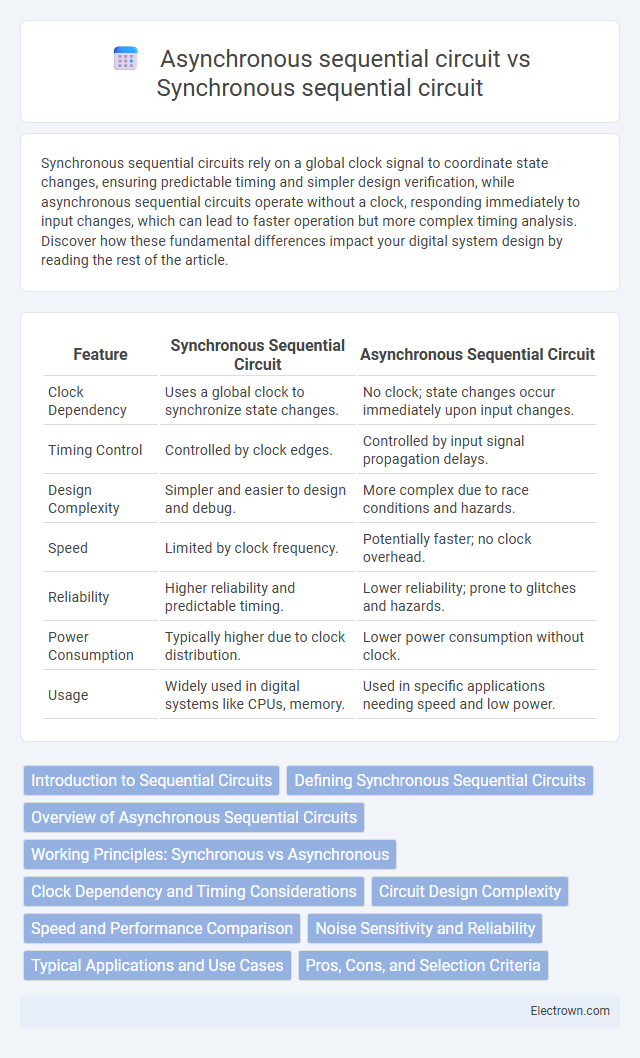Synchronous sequential circuits rely on a global clock signal to coordinate state changes, ensuring predictable timing and simpler design verification, while asynchronous sequential circuits operate without a clock, responding immediately to input changes, which can lead to faster operation but more complex timing analysis. Discover how these fundamental differences impact your digital system design by reading the rest of the article.
Table of Comparison
| Feature | Synchronous Sequential Circuit | Asynchronous Sequential Circuit |
|---|---|---|
| Clock Dependency | Uses a global clock to synchronize state changes. | No clock; state changes occur immediately upon input changes. |
| Timing Control | Controlled by clock edges. | Controlled by input signal propagation delays. |
| Design Complexity | Simpler and easier to design and debug. | More complex due to race conditions and hazards. |
| Speed | Limited by clock frequency. | Potentially faster; no clock overhead. |
| Reliability | Higher reliability and predictable timing. | Lower reliability; prone to glitches and hazards. |
| Power Consumption | Typically higher due to clock distribution. | Lower power consumption without clock. |
| Usage | Widely used in digital systems like CPUs, memory. | Used in specific applications needing speed and low power. |
Introduction to Sequential Circuits
Sequential circuits store and process data based on the order of input signals and their timing, with output dependent on both current inputs and past states. Synchronous sequential circuits rely on a clock signal to synchronize state changes, ensuring predictable and coordinated timing across the system. Asynchronous sequential circuits operate without a global clock, triggering state transitions immediately in response to input changes, often resulting in faster but more complex timing behavior.
Defining Synchronous Sequential Circuits
Synchronous sequential circuits rely on a global clock signal to coordinate state changes, ensuring all memory elements update simultaneously. These circuits use flip-flops triggered by clock edges, enabling predictable timing and simplifying design verification. Their operation contrasts with asynchronous sequential circuits, which lack a central clock and depend on signal propagation delays for state transitions.
Overview of Asynchronous Sequential Circuits
Asynchronous sequential circuits operate without a global clock, relying on changes in input signals to trigger state transitions immediately. These circuits are faster in response time and consume less power compared to synchronous sequential circuits but are more complex to design due to potential race conditions and hazards. Your choice between asynchronous and synchronous designs depends on the timing requirements, complexity, and power constraints of the application.
Working Principles: Synchronous vs Asynchronous
Synchronous sequential circuits operate based on a global clock signal that coordinates state changes, ensuring predictable timing and easy design verification. Asynchronous sequential circuits change states immediately in response to input changes without relying on a clock, leading to faster responses but increased design complexity due to potential race conditions. Your choice between these circuit types depends on the required speed, complexity, and timing reliability for your application.
Clock Dependency and Timing Considerations
Synchronous sequential circuits rely on a global clock signal to trigger state changes, ensuring predictable timing and simplified design verification. Asynchronous sequential circuits operate without a clock, causing state transitions to depend on input changes and internal gate delays, which introduces complex timing hazards like race conditions and glitches. The clock dependency in synchronous circuits enables controlled timing analysis, while asynchronous circuits require careful delay modeling to prevent metastability and timing errors.
Circuit Design Complexity
Synchronous sequential circuits exhibit lower design complexity due to their reliance on a global clock signal that simplifies timing control and state transitions. Asynchronous sequential circuits require intricate timing analysis and hazard prevention mechanisms, leading to increased design challenges and potential race conditions. Understanding your system's timing requirements can help determine whether synchronous or asynchronous design best manages complexity.
Speed and Performance Comparison
Synchronous sequential circuits operate based on a global clock signal, ensuring predictable timing and stable performance, which generally results in higher speed and better performance under controlled conditions. Asynchronous sequential circuits do not rely on a clock, allowing potentially faster response times due to immediate state changes but often suffer from issues like glitches and race conditions that can degrade overall reliability and speed. Understanding these differences helps you optimize circuit design choices based on required speed and performance metrics.
Noise Sensitivity and Reliability
Synchronous sequential circuits exhibit higher noise immunity due to their reliance on a global clock signal, which synchronizes state changes and reduces timing uncertainties. In contrast, asynchronous sequential circuits are more susceptible to noise because state transitions depend on input signals and internal feedback without a coordinating clock, increasing the risk of glitches and metastability. Your choice between these designs can impact system reliability, with synchronous circuits generally preferred for environments demanding robust noise tolerance.
Typical Applications and Use Cases
Synchronous sequential circuits are widely used in digital systems requiring precise timing, such as microprocessors, memory devices, and communication protocols, where a global clock synchronizes operations to ensure reliable data processing. Asynchronous sequential circuits find applications in low-power devices, speed-critical systems, and environments with variable input timing, including high-speed data transfer, asynchronous communication, and certain control systems where waiting for clock pulses may cause inefficiency. Understanding the differences in timing control between these circuits helps you select the appropriate design for your specific application needs.
Pros, Cons, and Selection Criteria
Synchronous sequential circuits offer predictable timing and easier design verification due to a global clock, making them suitable for complex systems requiring reliable operation, but they consume more power and may face clock skew issues. Asynchronous sequential circuits excel in power efficiency and can operate faster without a global clock, yet they pose challenges in design complexity and hazard prevention, often leading to unpredictable timing. Selection criteria depend on application requirements: synchronous circuits fit high-speed, large-scale integration with stringent timing, while asynchronous circuits are preferred in low-power, event-driven contexts where timing flexibility is advantageous.
Synchronous sequential circuit vs asynchronous sequential circuit Infographic

 electrown.com
electrown.com